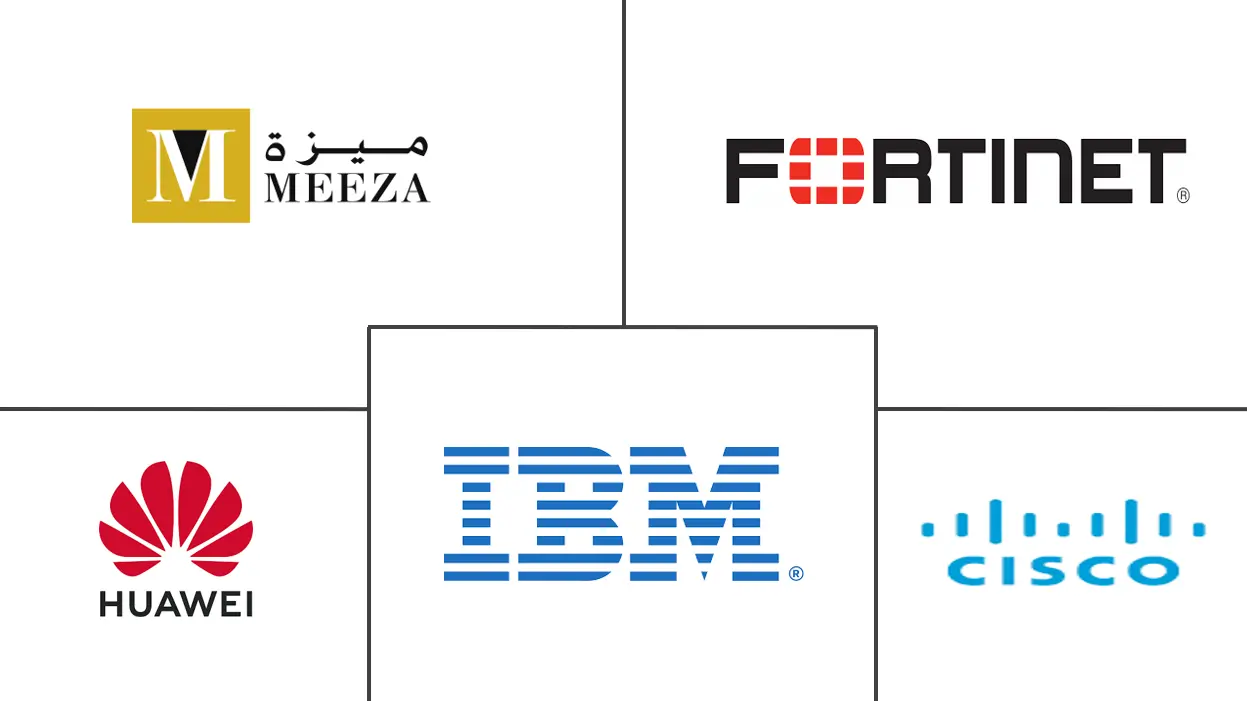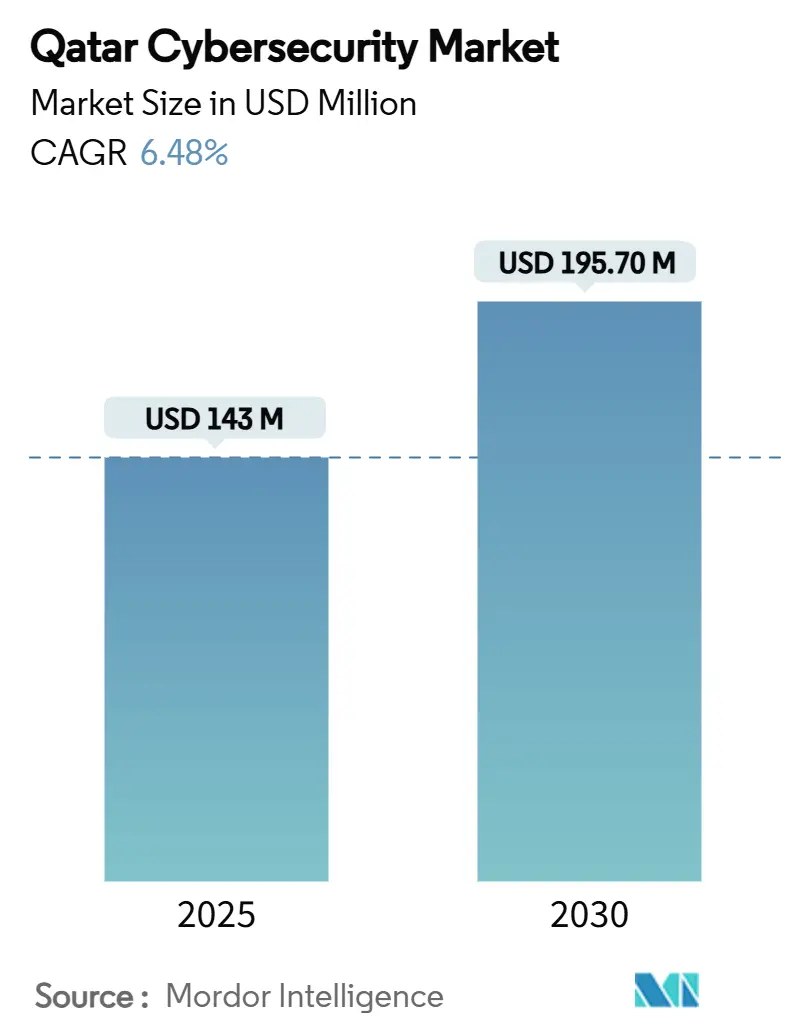
Qatar Cybersecurity Market Analysis by Mordor Intelligence
The Qatar cybersecurity market size stands at USD 143 million in 2025 and is forecast to reach USD 195.7 million by 2030, advancing at a 6.48 % CAGR across the period. The uptick is rooted in National Cyber Security Strategy (NCSS 2022) mandates, the TASMU cloud-first agenda, and enduring protections for FIFA 2022 smart-city infrastructure. Compliance spending is no longer discretionary; ministries, energy majors, and banks now embed cyber budgets in core operating costs. LNG operators are hardening industrial control systems after a wave of OT ransomware incidents, while financial firms boost API security to meet open-banking rules. Hyperscale cloud builds by Microsoft and other providers satisfy data-residency concerns, catalyzing a shift from perimeter defenses to cloud-native controls. Finally, acute Arabic-speaking talent shortages elevate managed-service demand, pushing vendors toward automation and integrated platforms.
Key Report Takeaways
- By offering, solutions retained 62.40 % of Qatar cybersecurity market share in 2024; services record the fastest growth at a 9.80 % CAGR through 2030.
- By deployment model, on-premise led with 61.10 % of the Qatar cybersecurity market size in 2024, while cloud deployments expand at 11.10 % CAGR to 2030.
- By end-user industry, BFSI captured 27.50 % revenue share in 2024; healthcare is projected to advance at a 9.40 % CAGR through 2030.
- By end-user enterprise size, large enterprises held 68.50 % of 2024 demand, whereas SMEs are forecast to grow at 10.20 % CAGR to 2030.
Qatar Cybersecurity Market Trends and Insights
Drivers Impact Analysis
| Driver | (~) % Impact on CAGR Forecast | Geographic Relevance | Impact Timeline |
|---|---|---|---|
| State-mandated Critical Infrastructure Protection Law (NCSS 2022) boosts compliance spending | +1.80% | National, with priority focus on Doha and industrial zones | Medium term (2-4 years) |
| Surge in OT attacks on LNG facilities of QatarEnergy driving ICS/SCADA security demand | +1.20% | National, concentrated in Ras Laffan and North Field operations | Short term (≤ 2 years) |
| FIFA 2022 legacy Smart-City assets (5G, IoT) require robust cyber safeguards | +0.90% | National, with emphasis on Doha metropolitan area | Long term (≥ 4 years) |
| TASMU cloud-first program accelerating cloud–native security adoption | +1.10% | National, government and enterprise sectors | Medium term (2-4 years) |
| FinTech and open-banking rules (QCB) expanding IAM and payment-security budgets | +0.70% | National, concentrated in financial districts | Medium term (2-4 years) |
| Mandatory personal-data law (Law 13/2016) raising encryption and DLP uptake | +0.60% | National, cross-sector compliance requirement | Long term (≥ 4 years) |
| Source: Mordor Intelligence | |||
State-mandated Critical Infrastructure Protection Law (NCSS 2022) boosts compliance spending
NCSS 2022 appoints the National Cyber Security Agency (NCSA) as a single enforcement body, compelling critical operators to run annual risk audits, deploy incident-response plans, and report breaches within 72 hours [1]National Cyber Security Agency, “Cybersecurity Strategy 2022,” ncsa.gov.qa. Energy, telecom, and transport entities now draft multi-year cyber-capex programs that fold both IT and OT domains into one architecture. Compliance urgency compresses procurement cycles and funnels demand toward integrated governance-plus-control suites that reduce tool sprawl.
Surge in OT attacks on LNG facilities of QatarEnergy driving ICS/SCADA security demand
Resecurity research shows an 80 % year-on-year rise in ransomware targeting global energy assets, with QatarEnergy reporting increased probing of SCADA networks. Operators retrofit deep-packet inspection and unidirectional gateways to protect production lines while sustaining 24/7 availability. Vendors demonstrating protocol-aware anomaly detection are winning multi-site rollouts across Ras Laffan.
FIFA 2022 legacy Smart-City assets (5G, IoT) require robust cyber safeguards
IoT sensors, 5G nodes, and AI command centers installed for the World Cup now support everyday urban services under the TASMU platform. Their heterogeneous firmware and limited in-device protection enlarge the national attack surface. Municipal ICT teams therefore outsource continuous monitoring and edge-device patching to managed providers that guarantee Arabic dashboards and local-data processing.
TASMU cloud-first program accelerating cloud–native security adoption
The Ministry of Communications directs agencies to prioritize cloud, driving bulk workload migration to Microsoft’s Doha data-center region launched in 2024. Procurement managers favor cloud-security-posture-management and container-security tools bundled with local compliance templates, accelerating platform revenue.
Restraints Impact Analysis
| Restraint | (~) % Impact on CAGR Forecast | Geographic Relevance | Impact Timeline |
|---|---|---|---|
| Scarcity of Arabic-speaking cyber-talent inflates MSSP costs | -0.80% | National, with acute shortages in specialized roles | Medium term (2-4 years) |
| Legacy OT assets in gas terminals complicate security integration | -0.60% | National, concentrated in industrial facilities | Long term (≥ 4 years) |
| Fragmented procurement across semi-government firms slows project cycles | -0.40% | National, affecting government and quasi-government sectors | Short term (≤ 2 years) |
| Data-sovereignty concerns over foreign cloud SOC hosting | -0.50% | National, impacting cloud adoption decisions | Medium term (2-4 years) |
| Source: Mordor Intelligence | |||
Scarcity of Arabic-speaking cyber-talent inflates MSSP costs
Doha records 434 cybersecurity vacancies per 100,000 citizens, second-highest in the region [2]Edoxi Institute, “Middle East Cyber-Talent Shortage,” edoxi.com. Importing experts inflates MSSP rates, while local academies need several cohorts before easing the gap. Automation and AI-driven triage partially offset staffing shortfalls but raise initial platform costs.
Legacy OT assets in gas terminals complicate security integration
Decades-old PLCs and distributed-control systems lack encryption and vendor support. Waterfall Security Solutions notes that upgrades must avoid accidental shutdowns, so engineers favor unidirectional “data-diode” links that isolate plant networks. Project timelines stretch, tempering short-run spend.
Segment Analysis
By Offering: Services Expand as Expertise Becomes Scarce
Solutions command 62.40 % of Qatar cybersecurity market share, led by integrated platforms that unify SIEM, SOAR, and zero-trust controls. Yet services grow at 9.80 % CAGR as boards realize technology without manpower cannot satisfy NCSS audit checks. Consulting firms deliver gap analyses and architecture roadmaps, while MSSPs supply 24/7 SOC cover—an attractive choice amid the Arabic-talent deficit. Many bids now bundle multi-year monitoring clauses, turning upfront product deals into recurring revenue.
Simultaneously, managed-detection-and-response packages tailored for industrial protocols are gaining traction inside LNG complexes. Providers combine passive network taps with threat-hunting teams fluent in Arabic and Modbus packets. Their premium pricing finds acceptance because plant outages can cost millions per hour. Over time, the service-heavy model is likely to erode pure-product dominance.
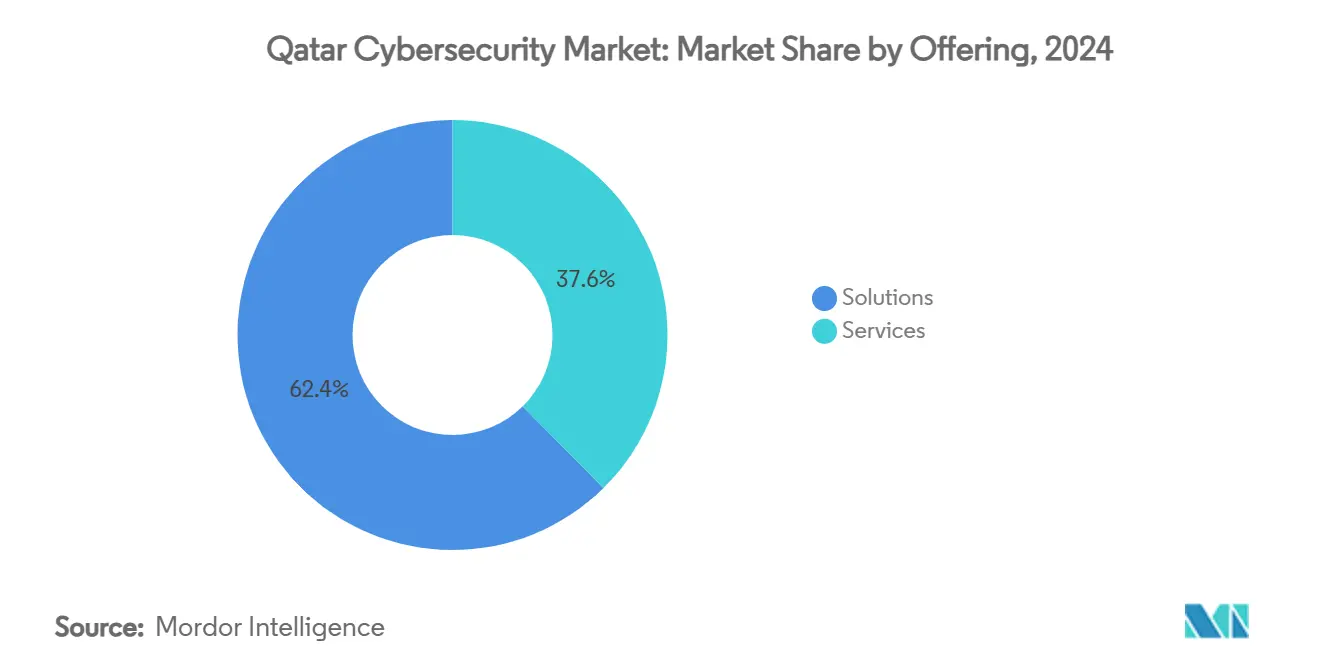
By Deployment Mode: Cloud Momentum Alters Spending Mix
On-premise still accounts for 61.10 % of the Qatar cybersecurity market size thanks to sovereignty rules and ingrained risk culture. Defense agencies and energy SCADA rooms keep hardware under local custody and demand private-cloud editions of software. Nonetheless, cloud deployments book an 11.10 % CAGR, helped by hyperscale regions that meet residency clauses and by TASMU’s cloud-first policy.
Hybrid architectures are now standard. Banks synchronize SIEM logs from branch appliances to cloud analytics engines, gaining machine-learning insights without exporting raw customer data abroad. Telecoms off-load sandboxing and malware analysis to cloud nodes for elasticity during traffic spikes. Vendors that provide unified policy engines spanning appliances and SaaS consoles convert proof-of-concept pilots into enterprise-wide rollouts.
By End-user Industry: Healthcare Accelerates while BFSI Leads
BFSI retains a 27.50 % revenue lead, driven by instant-payment rails and API-based open-banking schemes that demand fine-grained identity control. The Qatar Central Bank now obliges firms to log all security events and run quarterly penetration tests [3]Qatar Central Bank, “Information Security Guidelines 2024,” qcb.gov.qa. Spending pivots toward adaptive authentication and fraud-analytics modules integrated with core banking.
Healthcare posts the fastest 9.40 % CAGR as hospitals digitalize imaging and patient portals. Electronic health records require encryption at rest, intrusion monitoring, and zero-trust network segmentation. Medical-device makers cooperate with clinics to roll out firmware-over-the-air updates validated by cryptographic signatures, promoting a lifecycle-security mindset that was absent pre-pandemic.
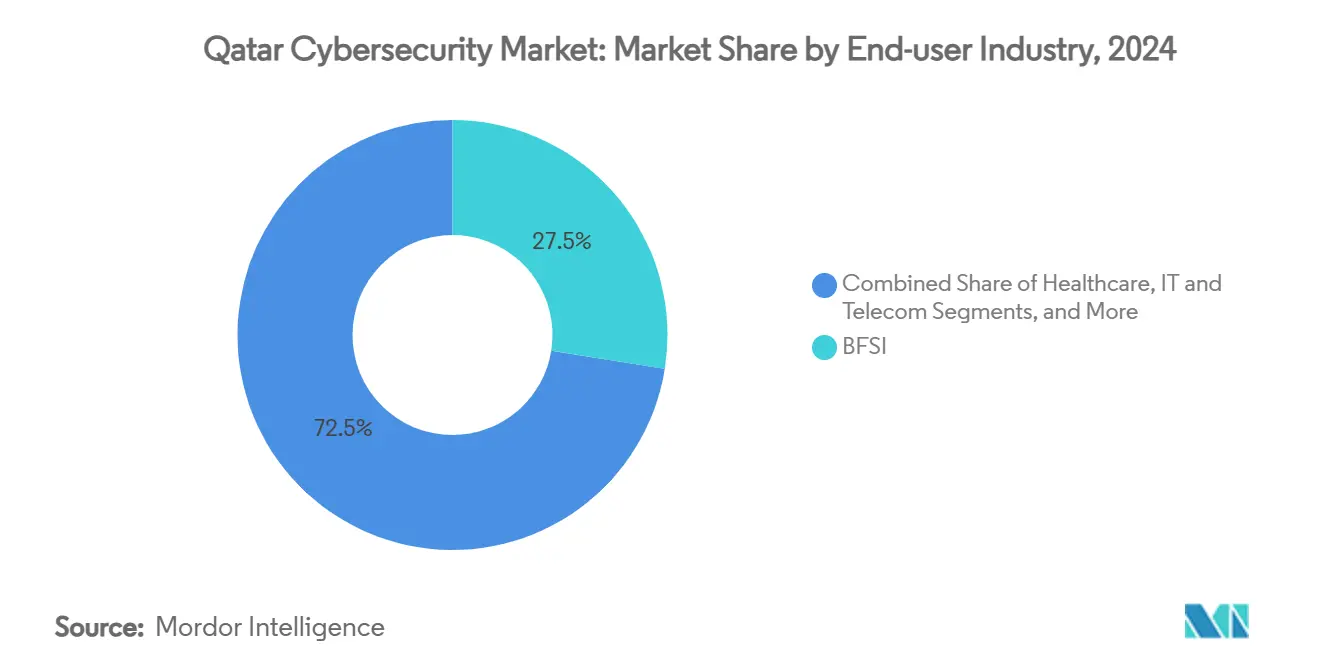
Note: Segment shares of all individual segments available upon report purchase
By End-user Enterprise Size: SMEs Spark Future Uptake
Large corporations contribute 68.50 % of 2024 demand, running layered defenses that weave governance, risk, and compliance dashboards into board reporting. Their budgets absorb advanced features like deception grids and quantum-safe VPNs. However, SMEs clock a 10.20 % CAGR because cloud subscriptions lower entry costs. Qatar Development Bank’s digitization loan program reimburses up to 50 % of cyber spend for qualifying firms [4]Qatar Development Bank, “Technology & Digitization Financing,” qdb.qa.
Platform vendors respond with starter bundles: identity, email security, and backup delivered from domestic data centers. These packages sync to mobile dashboards in Arabic, enabling owners to monitor threats without specialist staff. As supply-chain regulations tighten, even micro-enterprises supplying energy majors must show baseline cyber hygiene, magnifying SME demand.
Geography Analysis
Qatar’s compact geography centralizes most cyber demand into the Doha metropolitan cluster, home to ministries, regulators, and financial headquarters. Here, the Qatar cybersecurity market witnesses high per-capita spend as agencies pursue NCSS accreditation and banks deploy real-time fraud engines. Proximity facilitates rapid vendor-client engagement and supports localized Arabic SOC operations.
Industrial corridors such as Ras Laffan, Mesaieed, and Dukhan drive a distinct subset of spending focused on operational-technology hardening. LNG trains, petrochemical plants, and export terminals prioritize deterministic latency and safety integrity, shaping a procurement bias toward passive monitoring, unidirectional gateways, and ruggedized firewalls. Vendors must hold industrial-safety certifications to qualify, creating a barrier to new entrants.
A third axis emerges around hyperscale data-center campuses situated in Umm Al Houl Economic Zone. These facilities anchor cloud-security investments and enable Qatar to position itself as a regional cyber-services hub. Cross-border managed-security contracts now route through Doha nodes, leveraging low-latency fiber into GCC neighbors. The concentration of compute resources spurs ecosystem spin-offs in threat-intelligence, DevSecOps, and quantum-resistant research.
Competitive Landscape
The Qatar cybersecurity market features moderate concentration. Global leaders—IBM, Cisco, Palo Alto Networks, and Fortinet—bundle network, endpoint, and cloud controls into platform deals favored by ministries. Their local channel alliances fast-track compliance mapping and Arabic UI translations, sustaining a combined 45 % share.
Regional specialists such as Help AG and Spire Solutions differentiate through Arabic threat-intelligence feeds and round-the-clock SOCs staffed in Doha. Their familiarity with local tender law accelerates paperwork and shortens proof-of-concept timelines. They also co-develop training curricula with the National Cyber Security Agency, elevating public-sector trust.
Emergent firms like Techno Q and TeamSec exploit whitespace in OT security and AI-driven analytics. Backed by venture rounds and TASMU Accelerator exposure, they roll out modular services priced for SMEs yet robust enough for Tier-1 energy assets. Joint-solution blueprints with Microsoft and Quantinuum demonstrate a trend toward ecosystem play, where niche IP plugs into hyperscaler platforms.
Qatar Cybersecurity Industry Leaders
-
IBM Corporation
-
MEEZA QSTP
-
Cisco Systems Inc.
-
Fortinet Inc.
-
Huawei Technologies Co. Ltd.
- *Disclaimer: Major Players sorted in no particular order
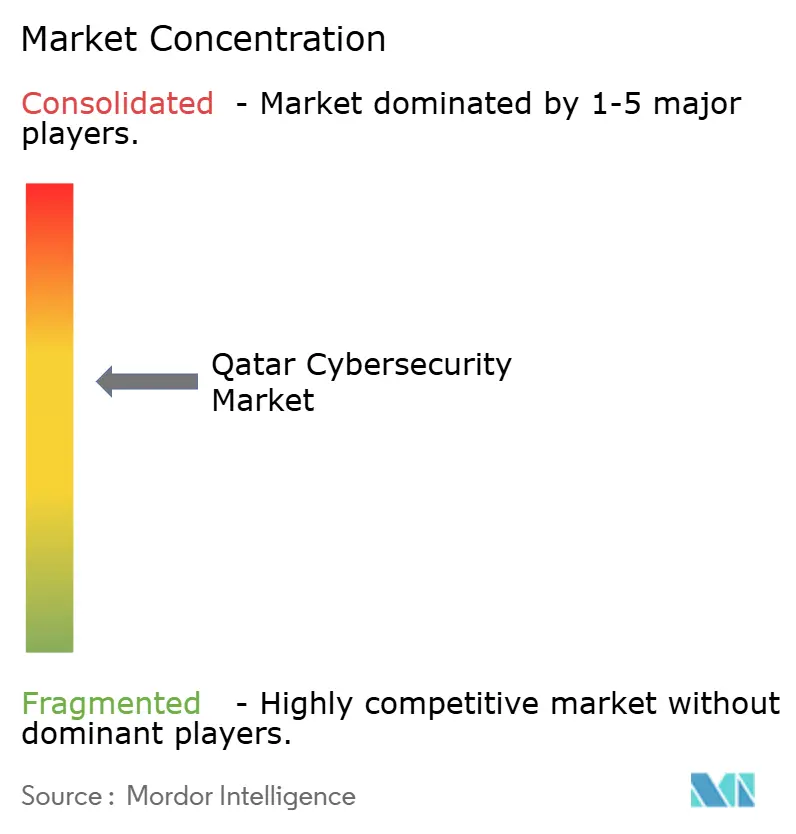
Recent Industry Developments
- May 2025: Invest Qatar and Quantinuum agree to co-develop quantum-resistant cybersecurity offerings targeting critical-infrastructure operators.
- April 2025: Techno Q launches an IT Business Unit focusing on managed cyber services for GCC markets.
- March 2025: Ooredoo partners with Evina to deploy AI-powered fraud prevention across carrier billing, blocking real-time mobile-payment attacks.
- January 2025: Venture funds Rasmal and Deniz Ventures invest USD 7.6 million in TeamSec, bolstering regional cyber-startup activity.
Qatar Cybersecurity Market Report Scope
Cybersecurity solutions help organizations detect, monitor, report, and counter cyber threats to maintain data security and confidentiality. The adoption of cybersecurity solutions is anticipated to grow in line with the rising internet penetration among developing and developed countries. The demand for cybersecurity has increased as every system in today's world is connected to the internet, making data more accessible to cybercriminals.
The Qatar cybersecurity market is segmented by offerings (solutions [application security, cloud security, data security, identity access management, infrastructure protection, integrated risk management, network security, end-point security, and other solution types] and services [professional services and managed services]), by deployment (On-premise, and cloud), by organization size (SMEs, large enterprises), by end-user vertical (BFSI, healthcare, IT and telecom, industrial and defense, retail, energy and utilities, manufacturing, and other end-user industries). The market sizes and forecasts are provided in terms of value in (USD) for all the above segments.
| Solutions | Application Security |
| Cloud Security | |
| Data Security | |
| Identity and Access Management | |
| Infrastructure Protection | |
| Integrated Risk Management | |
| Network Security | |
| End-point Security | |
| Services | Professional Services |
| Managed Services |
| Cloud |
| On-Premise |
| BFSI |
| Healthcare |
| IT and Telecom |
| Industrial and Defense |
| Retail and E-commerce |
| Energy and Utilities |
| Manufacturing |
| Others |
| Large Enterprises |
| Small and Medium Enterprises (SMEs) |
| By Offering | Solutions | Application Security |
| Cloud Security | ||
| Data Security | ||
| Identity and Access Management | ||
| Infrastructure Protection | ||
| Integrated Risk Management | ||
| Network Security | ||
| End-point Security | ||
| Services | Professional Services | |
| Managed Services | ||
| By Deployment Mode | Cloud | |
| On-Premise | ||
| By End-user Industry | BFSI | |
| Healthcare | ||
| IT and Telecom | ||
| Industrial and Defense | ||
| Retail and E-commerce | ||
| Energy and Utilities | ||
| Manufacturing | ||
| Others | ||
| By End-user Enterprise Size | Large Enterprises | |
| Small and Medium Enterprises (SMEs) | ||
Key Questions Answered in the Report
What is the projected value of the Qatar cybersecurity market by 2030?
The market is expected to reach USD 195.7 million by 2030.
Which segment grows fastest within the Qatar cybersecurity market?
Cloud deployments post an 11.10 % CAGR, the highest among deployment models.
Why is OT security critical for Qatar?
LNG facilities form a major economic pillar, and cyber-induced downtime could disrupt global energy supply chains.
How does the TASMU program influence security purchasing patterns?
TASMU’s cloud-first directive shifts budgets toward cloud-native posture-management and container-security suites.
Page last updated on:
